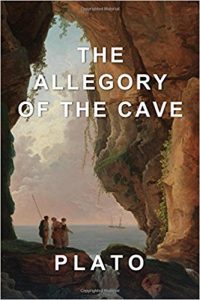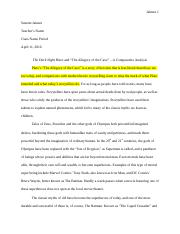

Therefore, people do happen to be locked out of the rest of the world and unable to evaluate the situation adequately. Indeed, the opinion suggested by Plato in his timeless argument is quite valid applied even to present-day realities.įor example, as Grinsby explains, modern military conflicts within independent states, which are discussed worldwide, can still be hardly understood by the representatives of other countries, as opposed to the way in which the local residents view the situation: “Still, you might come away with these accounts with the disturbing sense that you still did not understand what really happened in either Afghanistan or Iraq” (Grigsby 75). People are restricted by the five senses that they have, and they often rely on these senses too much without trying to use their analytical skills in order to understand why they see things in a certain way and not in the other one. While reality as a phenomenon can be defined as a combination of the sensations that people receive from the world around them and the way in which they analyze these sensations, Plato’s argument does have a very legitimate point. An Alternative Vision on the Allegory of the Cave Therefore, “what he previously saw ” (Plato 515) and which “was more unhidden than what was now being shown ” (Plato 515) would simply no register on the viewer’s radar, since, deprived of their senses, people are unable to cognize the reality. Plato’s argument presupposes that there is the general truth, which remains disclosed from people the reality, however, seems to have nothing to conceal and is only based on people’s projection of their egos onto the blank sheets of history. Seeing that reality can be identified as the projection of one’s values onto the actual neutral situation, considering people inside the cave and their interpretations of the shadows on the walls as a model of the real world and the relationships between people in it is not quite right. While Plato seems to have ignored the definition of reality in his work, it bears a huge significance to the outcome of the argument. Therefore, it is logical to suggest that, outside of the context of sensations, reality does not exist, since there is no one to sense it. In other words, reality as people have identified it consists of the sensations that people receive and the way in which they interpret these sensations. With all due respect to Plato and his philosophy, the idea of people misinterpreting the reality because of the faultiness of their senses does not seem as legitimate as it should.įirst and most obvious, the very definition of reality is based on the information, which people retrieve from the world around them. The Allegory of the Cave as a Representation of Reality

Though Plato’s idea of how people see the world around them does have a legitimate point, it seems that the characteristics of reality are defined by people’s senses and do not exist outside people’s sensory system as a result, the idea of cognizing the world solely through logics, while admittedly clever, may possibly lead to no tangible results. Who are forced to see solely the shadows of the real objects and, as a result, doomed to being mistaken about the world that they live in (Grigsby 76). Set in a form of a dialogue, the allegory represents the reality of people. The Allegory of the Cave must be one of Plato’s most famous hypotheses regarding the mechanics of reality. The Inward Civility of the Mind: The 1735 Grand Oration of Martin Clare, F.R.S.Introduction: Plato’s Allegory of the Cave.The Smithsonian’s “Masonic” Mizraḥ: A Mystery Laid to Rest.The Essential Secrets of Masonry: Insight from an American Masonic Oration of 1734.

Book review of British Freemasonry, 1717–1813.“To the God-like Brother”: John Parke’s Ode to Masonry and George Washington, 1779.



 0 kommentar(er)
0 kommentar(er)
